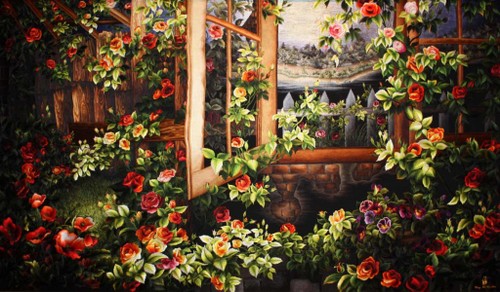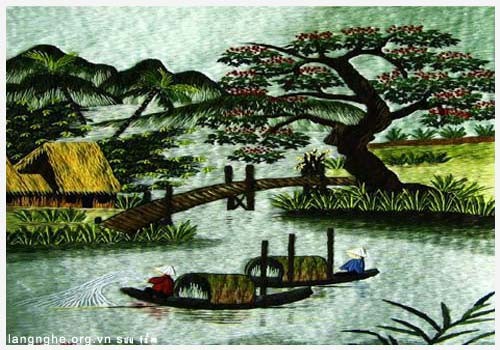Hello and welcome to VOV’s Letter Box, a weekly feature dedicated to our listeners around the world. We are Ngoc Huyen and Nhat Quynh.
A: First on our show today, we’d like to acknowledge a reception report from Richard Lemke of Canada who listened to VOV’s broadcast on March 26 on the frequency of 7315 khz.
B: Mr. Lemke wrote: “Thanks for the QSL card for January 2017 and gift of a picture. The artwork is very impressive. Could you tell me what type of artwork this is?”
A: We think we sent you an embroidery painting of Ha Long Bay. Embroidery painting is a popular craft in many localities throughout Vietnam. XQ embroidery, for example, is a famous hand embroidery shop in Da Lat designed to look like a traditional and historical rural village.

An embroidery picture by XQ |
B: XQ hand embroidery pictures embody Vietnamese culture, so they make a nice souvenir for foreign visitors. You can watch the artisans at work in the embroidery workshop and gallery and enjoy a complimentary glass of green tea as you wander around.
A: Da Lat XQ Historical Village is not a new tourist destination but it is an interesting place for tourists to explore. At XQ Historical Village the hand embroideries are exquisite and unique.
A: XQ Historical Village was built by the XQ Embroidery Company near the Valley of Love. Here skilled craftswomen put their soul into each stitch of their lifelike pictures.

An embroidery picture by XQ
|
B: XQ embroidery pictures are more than merely decorative. They are artworks of mysterious beauty.
A: Quat Dong embroidery craft village in Thuong Tin district, about 25 kilometers south of Hanoi, is the cradle of embroidery in Vietnam. Its brand name is famous nationwide. Its reputation has remained strong since the 17th century.
B: Children in the village are taught to embroider at the age of 7 or 8. In this way they carry on their ancestors’ profession. Each household has at least two or three people following the craft.
A: Quat Dong is famous for landscape embroidery pictures - banyan trees, river wharfs, and scenic spots like the One Pillar Pagoda, Ngoc Son Temple, Hong Thai Communal House, and Hue Imperial City.

Quat Dong embroidery picture |
B: It takes months an embroiderer to complete a picture. Quat Dong has many well-known artisans, including Master Bui Le Kinh, who used to embroider royal garments for King Bao Dai and Queen Nam Phuong. Now the only villager holding the title People’s Artisan is Mr. Thai Van Bon, who is famous for embroidering portraits of state leaders. His embroidery portrait of the Thai King has received international praise.
A: In his letters to VOV this week, Fumito Hokamura of Japan sent us reception reports for VOV broadcasts on March 13th and March 14th on the frequency of 12020 khz. He wrote that he like Vietnamese lullabies.
B: The lullaby, a priceless cultural asset of the Vietnamese, passes down to children the spiritual values of the community. The lullaby is a precious life-affirming lesson that helps form personalities and ethics.
A: From the day they are born, children absorb the most loving, sweetest feelings of their mothers and grandmothers through lullabies. A lullaby is soft, sweet and emotional. It expresses the meaning of life.
B: Images of rivers, moonlight, rice fields, grass, bamboo groves and white storks flying over a vast green rice field have entered childhood dreams. The lyrics, taken from folk verses and children’s songs or chants, are simple and rich in images. Each region has its own lullabies, but all can lull a child to sleep.
A: That was one of Vietnamese lullabies called “Mother loves child”. Listening to lullabies, children feel love, tenderness, and comfort. “Baby, sleep well! Your mom is busy planting rice seedlings. Catching some fish, cat fish, she will bring them home for you, baby, to eat”.
B: The image of a mother singing lullabies and rubbing her child’s head and back is unforgettable. Even if she is not a singer, her voice is expressive.
A: A lullaby which is passed down orally has many variants. With urbanization and the modern lifestyle, mothers have less time for their child and there are fewer opportunities for songs. To preserve the lullaby, lullaby festivals have been organized in various localities throughout Vietnam.
B: Here is a letter from Jayanta Chakrabarty of India. He shared with us a story about the celebration of the 45th anniversary of Vietnam-India diplomatic ties. He wrote: “This happy occasion is being celebrated with much funfare in India. Recently, an art exhibition was held at the Indira Gandhi National Center for the Arts in New Delhi featuring the works of 20 renowned artists from Vietnam. I was able to meet Ms Luong Thi Giang, an oil painter from Hanoi. The most memorable exhibits were the intricate pen sketches and paintings depicting the seasons of Vietnam.”
A: Thank you, Mr, Chakrabarty, for sharing your story with us. A lot of activities will be held in Vietnam and India this year because the two countries are celebrating the 45th anniversary of their diplomatic ties. We look forward to hearing more stories from you.
B: We’d like to acknowledge a letter from Harald Suss of Austria, who listened to our broadcast on June 25th, 2016 on the frequency of 12005 khz during a trip through Nicaragua. This week, we received emails form Ram Babu Kumar and Rahul Ras, and Muhammad Shamim of India, Richard Nowak of the US, and Hector Frias Jofre of Chile. We’ll send you all QSL cards to confirm your reports.
A: We welcome your feedback at: English section, Overseas Service, Radio the Voice of Vietnam, 45 Ba Trieu Street, Hanoi, Vietnam. You can email us at: englishsection@vov.org.vn or visit us online at vovworld.vn where you can hear both live and recorded programs. Good bye until next time.